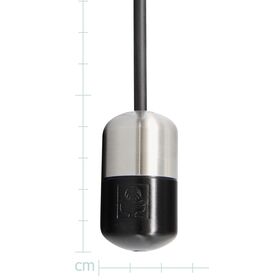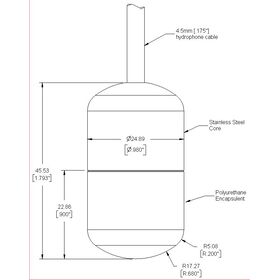The H1a hydrophone is designed to provide high-quality audio performance in a low-cost device. It is very durable and can interface directly with high-impedance microphone or instrument preamps (please read important footnote about audio interface below). It offers very good sensitivity and low noise in the human auditory range. The H1a’s streamlined shape and high specific gravity will help to maintain a low working depth in a moving water column. Its compact size and the easy hand of its cable make it very portable and simple to use.
The H1a offers the following advantages:
- Low cost
- Low self noise
- Good sensitivity
- Robust design handles accidental drops and temperature extremes
- Compact (4.5mm OD) Low-noise cable with tough urethane jacket
- Very high dynamic range
- Connects directly with 1/4" TS plug to High-impedance microphone circuits and musical instrument amps
- User can buy or build preamp to focus on application-specific systems
- High-quality REAN gold output connector
- Compact size and easy hand of cable
- High specific gravity and streamlined shape keeps hydrophone down in currents
- 1-year limited warranty
Recommended devices:
Use with the PA1 buffer or PA6 preamp listed on our Amplifiers Page for the perfect high-fidelity interface with your existing microphone preamp.
Use with the Honeytone amplified speaker for low-cost, portable PA system.
User Manual--includes specifications and warranty statement
Custom cable lengths: Select the custom option above, then buy hydrophone cable separately from the accessories menu. Leave notes at checkout with assembly details.
Audio interface notes: Please note that, though this hydrophone does work with most recorders and audio interfaces that offer a 1/4" microphone or instrument (line-level) input jack, the user should be very careful to ensure that the device offers adequately-high input impedance and gain. Recorders and computer sound interfaces that offer a DI or Instrument input that is compatible with direct connection to an electric guitar can work well, but many of these devices do not offer enough gain, resulting in poor sensitivity from the hydrophone. If you try to adapt to a 3.5mm or XLR microphone input, you will lose your low frequencies because of improper impedance matching. It is also possible, when connecting to a device with a 1Mohm or higher input impedance, that you will get unwanted acceleration noise which can saturate the preamp. If not using one of the recommended devices noted above, and you are unsure about compatibility with your device, please contact us for technical support with component compatibility.
Reseller accommodation and Quantity discounts: Please see our policies page for details.

H1a pictured with Honeytone Amplified Speaker.
The H1a is intended to be a lower-cost alternative to military and lab-grade hydrophones. Deriving high sensitivity and low noise from lower-cost components were made a priority over maintaining strict tolerances. These specifications are typical of a limited sample group and are not guaranteed. They are for basic comparison information only.
The H1a utilizes a passive piezo sound pickup. There is no preamp or impedance buffer circuit within the hydrophone. The advantages are that the hydrophone remains as simple and low cost as possible, it does not require any power, and it offers a very wide dynamic range. System gain and input impedance must be considered while choosing a preamp.
System gain is the amount of signal amplification required and will depend on the amplitude of the sounds that you are attempting to monitor, as well as what you are doing with the output. Generally speaking, if you are driving headphones or a line audio circuit, or working with a computer sound device, you may require 20 dB of gain for industrial monitoring, 40 ~ 50 dB for listening to cetaceans and large aquatic wildlife, and 60 dB or more for very distant or faint sounds.
Input Impedance is the amount of load that your preamp puts on the hydrophone. The low-frequency response of a piezo transducer, such as that used in the H1a, will be limited by the input impedance of the preamp. Higher input impedance will give you an extended low-frequency response. This relationship can be calculated for the H1a with the following formula:
Fc = 1 / 0.000000157 * R
Fc is the frequency at which electrical output is 3dB down from nominal and R is the input impedance of your preamp. Therefore, using a preamp with an input impedance of 300 Kohms will give you a low-frequency cutoff of 20 hertz—the low end of what humans can hear. A preamp with an input impedance of 100 Kohms might work well for the PA system on a whale-watching vessel, giving a Fc of 64 Hz, which is compatible with the capabilities of most speaker systems. The higher Fc might also help filter the extreme low frequency noise of the hydrophone rising and falling in the water as the boat moves on a swell.
¼” TS output (standard): If the numbers above are not obvious to you, just try to take note of whether any audio input is labeled “Hi-Z” or similar. Audio components that are built for electric guitars, such as combo amps, DI boxes and many USB audio interfaces are likely to work. Do note that not all will offer adequate gain for use recording very low-amplitude or distant sounds in quiet water, as guitars typically emit a stronger signal than hydrophones. The same ¼” jack is often used for line-level balanced and unbalanced signals. These types of inputs often found in mixing consoles and many digital recorders will not offer adequate sensitivity for the hydrophone and will likely filter low frequencies due to impedance mismatch. It is very unlikely that you will damage either the hydrophone or preamp by trying it.
BNC output (optional): BNC connectors are typically used on high-impedance amplifiers, such as
specifically built for hydrophones. It is also the most commonly used connector in test and measurement devices, such as oscilloscopes, spectrum analyzers, and more generalized data acquisition devices (DAQs). Nearly all of these devices will offer very high input impedance. In fact devices like these with input impedance exceeding 1Mohm and DC input coupling could experience problems with pickup of high levels if infrasound noise from acceleration and temperature change. If the signal from your hydrophone seems to cut out when the hydrophone is moved, this is probably a result if infrasound distortion and input impedance may need to be lowered.
For a downloadable version of this guide or additional care information, please see the H1a user manual.





